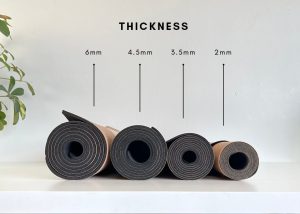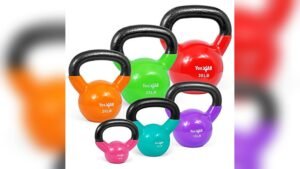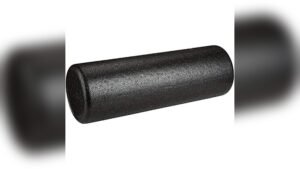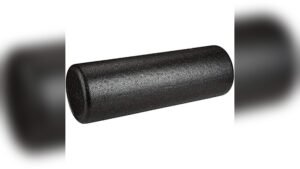A standard yoga mat thickness ranges from 1/8 inch (3.175 mm) to 1/4 inch (6.35 mm). Thicker mats offer more cushioning and support.
Choosing the right yoga mat thickness depends on your practice style and comfort needs. Thinner mats, around 1/8 inch, are ideal for balance-focused poses and traveling due to their lightweight nature. Thicker mats, such as those that are 1/4 inch, provide extra cushioning, making them perfect for restorative yoga or practitioners with sensitive joints.
It’s essential to consider your personal comfort and the type of yoga you practice regularly. A mat that suits your needs can enhance your overall experience and help prevent injuries. So, invest in a mat that best aligns with your practice and preferences.
Table of Contents
ToggleIntroduction To Yoga Mats
Yoga mats provide a comfortable surface for your practice. They help prevent injuries and enhance your yoga experience. Choosing the right yoga mat can make a significant difference in your practice.
Importance Of Thickness
Yoga mat thickness plays a crucial role in your comfort. Thicker mats offer more cushioning for your joints. They are ideal for people with sensitive knees or wrists. Thinner mats provide better stability for balancing poses. They help you feel more grounded.
| Mat Thickness | Best For |
|---|---|
| 1/8 inch (3 mm) | Stability in balancing poses |
| 1/4 inch (6 mm) | Extra cushioning for joints |
| 1/2 inch (12 mm) | High comfort and support |
Variety In Materials
Yoga mats come in different materials. Each material has unique benefits. PVC mats are durable and provide good grip. They are also easy to clean.
TPE mats are eco-friendly and lightweight. They offer excellent cushioning. Rubber mats provide superior traction and are biodegradable. They are suitable for vigorous practices.
- PVC Mats: Durable, good grip, easy to clean
- TPE Mats: Eco-friendly, lightweight, great cushioning
- Rubber Mats: Superior traction, biodegradable, for vigorous practices
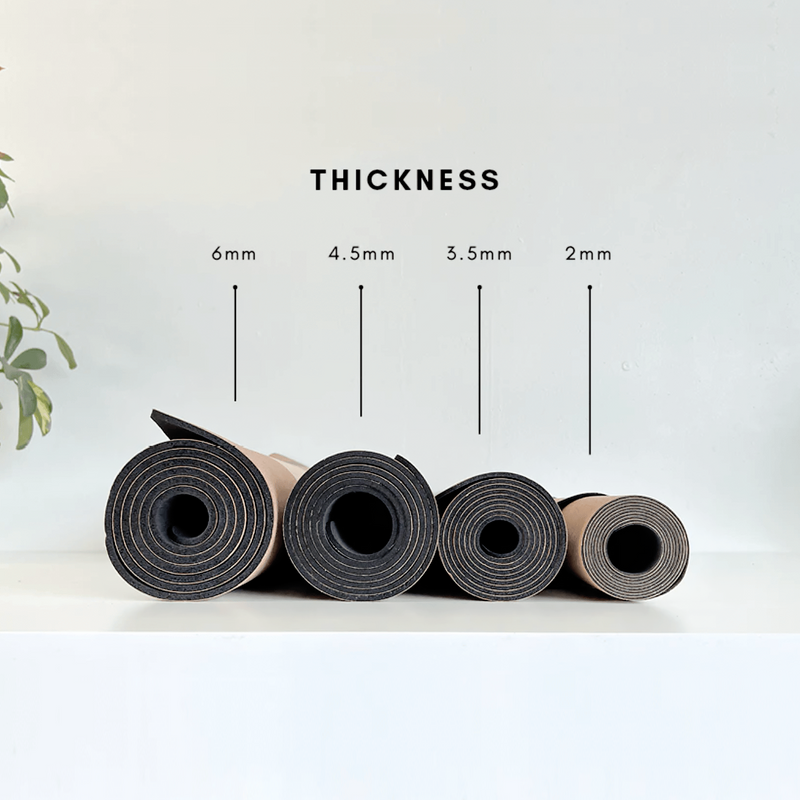
Credit: www.scoriaworld.com
Standard Yoga Mat Thickness
Choosing the right yoga mat is vital for your practice. The thickness of your yoga mat impacts comfort, stability, and portability. Understanding the standard thicknesses available can help you select the perfect mat for your needs.
Common Thicknesses
Yoga mats come in various thicknesses. Here are the most common options:
- 1/16 inch (2mm): Lightweight and portable.
- 1/8 inch (3mm): Standard thickness for many yoga practices.
- 1/4 inch (6mm): Extra thick for added comfort.
Pros And Cons
| Thickness | Pros | Cons |
|---|---|---|
| 1/16 inch (2mm) |
|
|
| 1/8 inch (3mm) |
|
|
| 1/4 inch (6mm) |
|
|
Consider these factors carefully to choose the best yoga mat thickness for you.
Thin Yoga Mats
Yoga mats come in various thicknesses, each serving a unique purpose. Thin yoga mats offer specific advantages for certain types of practices. Understanding their uses, benefits, and drawbacks helps you choose the right mat.
Ideal Uses
Thin yoga mats, typically 1/16 to 1/8 inch thick, are great for certain activities. They offer stability for balance poses and are easy to carry.
- Travel Yoga
- Hot Yoga
- Outdoor Yoga
These mats fit easily in backpacks, making them perfect for travel. They provide a firm surface for hot yoga, and their portability suits outdoor practice.
Benefits And Drawbacks
| Benefits | Drawbacks |
|---|---|
|
|
Thin yoga mats are easy to carry and provide stability. They are great for travel but offer less cushioning. These mats are not ideal for joint support and may wear out faster.

Credit: evolvefitwear.com
Thick Yoga Mats
Choosing the right yoga mat thickness can enhance your practice. A thick yoga mat offers unique benefits but also has drawbacks. Understanding when to use a thick mat is essential for your comfort and performance.
When To Choose Thick
A thick yoga mat, typically 6mm or more, provides extra cushioning. This can be beneficial for practitioners with sensitive joints or those who prefer a softer surface. If you practice on hard floors, a thick mat can protect your knees and elbows.
Thick mats are also suitable for restorative yoga or gentle stretching. They add comfort and reduce the impact on your body. For those who meditate for extended periods, a thick mat can provide the necessary support.
Advantages And Disadvantages
| Advantages | Disadvantages |
|---|---|
| Provides extra cushioning | Heavier to carry |
| Protects joints | Less stability for balance poses |
| Comfortable for long meditations | Can be bulky |
Advantages:
- Extra cushioning
- Joint protection
- Comfortable for meditation
Disadvantages:
- Heavy to carry
- Less stability for balancing
- Bulky to store
Specialty Yoga Mats
Choosing the right yoga mat can enhance your practice. Specialty yoga mats cater to unique needs. They offer specific benefits. Below, we explore some specialty options.
Travel Mats
Travel mats are perfect for yogis on the go. These mats are lightweight and compact. They fit easily in luggage. Most travel mats are around 1-2mm thick. This makes them easy to carry. Despite their thinness, they provide sufficient grip. This helps maintain stability during poses. Here is a quick comparison of popular travel mats:
| Brand | Thickness | Weight |
|---|---|---|
| Manduka eKO SuperLite | 1.5mm | 2.2 lbs |
| Jade Yoga Voyager | 1.6mm | 1.5 lbs |
| Gaiam Foldable | 2mm | 2 lbs |
Eco-friendly Options
Eco-friendly mats are made from sustainable materials. These mats are free from harmful chemicals. They are often biodegradable. Common materials include natural rubber and cork. Here are some benefits of eco-friendly mats:
- Non-toxic
- Sustainable production
- Biodegradable
- Durable and long-lasting
Popular eco-friendly yoga mats:
- Manduka PRO
- Jade Harmony
- Liforme Yoga Mat
Choosing the right specialty yoga mat can greatly improve your practice. Consider your needs and preferences.
Choosing The Right Thickness
Choosing the right thickness for your yoga mat can greatly impact your practice. The thickness of a yoga mat affects comfort, stability, and portability. It is important to find a balance that suits your needs.
Personal Preferences
Your personal preferences play a significant role in selecting the right thickness. Some people prefer thicker mats for added comfort. Others may find thinner mats offer better stability.
- Comfort: Thicker mats provide more cushioning.
- Stability: Thinner mats can offer more balance.
- Portability: Thinner mats are easier to carry.
Activity-based Choices
The type of yoga you practice can also influence your choice. Different activities may require different mat thicknesses.
| Yoga Type | Recommended Thickness |
|---|---|
| Hatha Yoga | 1/8 inch (3 mm) |
| Vinyasa Yoga | 1/4 inch (6 mm) |
| Yin Yoga | 1/2 inch (12 mm) |
For Hatha Yoga, a thinner mat of 1/8 inch (3 mm) is suitable. It offers enough cushioning while maintaining stability. Vinyasa Yoga practitioners may prefer a 1/4 inch (6 mm) mat. This thickness provides a balance between comfort and support. For Yin Yoga, a 1/2 inch (12 mm) mat is recommended. This offers extra cushioning for longer-held poses.
Maintaining Your Yoga Mat
Proper maintenance of your yoga mat ensures its longevity and hygiene. A well-kept mat enhances your yoga experience. Below are key tips for maintaining your yoga mat.
Cleaning Tips
Regular cleaning keeps your yoga mat fresh and germ-free. Use a mixture of water and mild soap. Avoid harsh chemicals as they damage the mat. Spray the solution on the mat and wipe it with a soft cloth.
For deep cleaning, soak your mat in a bathtub with water and mild detergent. Gently scrub it with a sponge. Rinse thoroughly to remove all soap residues. Hang it to dry completely.
Consider using yoga mat cleaners available in stores. These are designed specifically for mats and are gentle yet effective. Make sure to clean your mat after every practice to maintain hygiene.
Storage Solutions
Proper storage extends the life of your yoga mat. Always store your mat in a cool, dry place. Avoid direct sunlight as it can degrade the material.
Roll your mat loosely to avoid creases. Use a yoga mat strap or bag for easy transport and protection. Keep your mat away from sharp objects to prevent damage.
| Storage Tips | Benefits |
|---|---|
| Store in a cool, dry place | Prevents mold and mildew |
| Use a mat bag or strap | Protects from dust and damage |
| Avoid direct sunlight | Prevents material degradation |
By following these tips, your yoga mat remains in great condition. Enjoy a safe and pleasant yoga practice every time.

Credit: www.diyogi.com
Frequently Asked Questions
What Is The Best Thickness For A Yoga Mat?
The best thickness for a yoga mat depends on your needs. For comfort, choose a thicker mat around 6mm. For better balance, a thinner mat around 3mm is ideal.
Is a Thicker Yoga Mat Better?
A thicker yoga mat provides more cushioning, which is ideal for joint support. However, it may affect balance and stability during poses.
How Thick Should A Yoga Mat Be For Beginners?
Beginners should start with a mat that is 6mm thick. It offers extra cushioning, making it more comfortable for new yogis.
Does yoga Mat thickness affect performance?
Yes, mat thickness can impact your performance. Thinner mats offer better stability, while thicker mats provide more comfort and joint support.
Conclusion
Choosing the right yoga mat thickness enhances your practice and comfort. Consider your needs and preferences carefully. Balance cushioning and stability for the best experience. A well-chosen mat supports your journey and goals. Make an informed decision and enjoy your yoga practice to the fullest.

